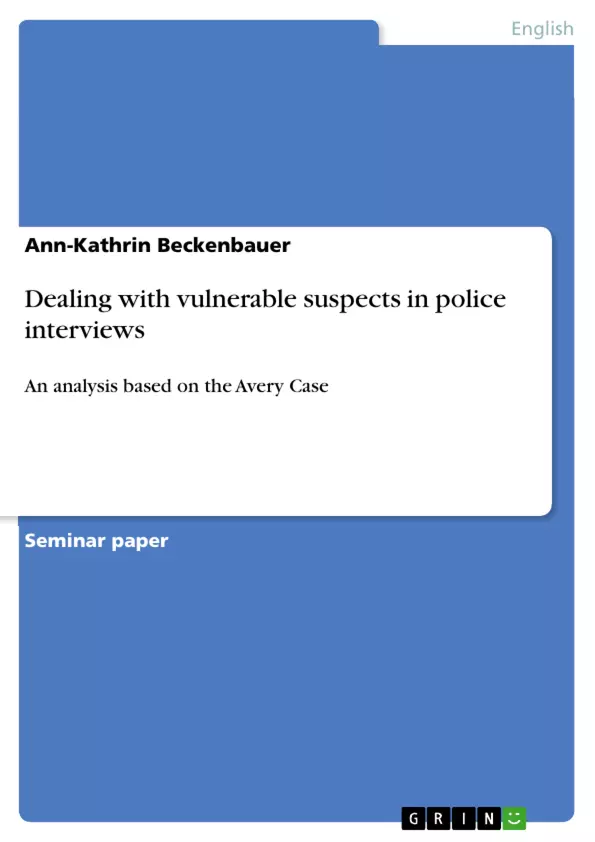To raise more awareness on this sensitive subject, this paper is going to deal with how policemen carry out suspect interrogations in order to obtain a suspect’s confession. Special attention is dedicated to the so called ‘vulnerable suspects’, which should be treated with a lot of care and sensitivity while conducting police interviews. In reality, some interrogation methods used by the police include accusations and are coercive, which tends to force vulnerable suspects to confess to a crime he or she has never committed. The consequences an innocent suspect has to face due to a forced confession can be far-reaching and, in the worst case, deadly.
In order to go more into detail, the following main section is subdivided into two main parts. The first one serves as an introductory part in which the theoretical frame of this paper is to be constructed. At first, there will be some basic information on the field of forensic linguistics and its origins. This explanatory section will contain definition approaches of the discipline of forensic linguistics and furthermore point out when and how it first came up and how it has developed since then. In addition, the wide range this discipline covers will be examined in more detail. The second chapter in this section will give an overview of the development of police interviews regarding its early approaches until now. Furthermore, this paragraph will also deal with the methods used by policemen in order to make a suspect confess, the interrogation techniques. Particular attention will be payed to the so-called ‘third degree’ methods and the ‘Reid Technique’, as well as the arising problem of false confessions, which is going to be pointed out in the last point of the explanatory part.
The second part of the main section serves as a practical part in which the before explicated theoretical frame will be applied to a selected sample text. At first, this paper will exemplify the worst case result of forced confessions. Based on some of the most popular cases up until now, the very harmful or even deadly consequences of miscarriages of justice for the affected person will be demonstrated. In the first paragraph, the paper will give an overview of the Steven Avery Case. This highly controversial case is a textbook example for miscarriage of justice and therefore is center of the Netflix series Making a Murderer.
Inhaltsverzeichnis (Table of Contents)
- Introduction
- Dealing with vulnerable suspects in police interviews based on the Avery Case
- Theoretical frame
- Basics of Forensic Linguistics
- The Origins of Forensic Linguistics.
- The Advancement of coercive police interviewing methods
- The Reid Technique
- Sample Text Analysis
- The Avery Case.....
- Analysis of Brendan Dassey's Interrogation........
- Theoretical frame
- Conclusion.........
- Bibliography..
Zielsetzung und Themenschwerpunkte (Objectives and Key Themes)
The paper examines the practices of police interrogation with a particular focus on vulnerable suspects. It aims to raise awareness about the potential for manipulation and coercion during interviews, specifically through the use of methods like the Reid Technique. The paper utilizes the Avery Case as a practical example of these issues, highlighting the consequences of forced confessions.
- Vulnerability in police interviews
- Coercive interrogation techniques
- The Reid Technique and its potential for false confessions
- The Avery Case as a case study of miscarriage of justice
- The role of forensic linguistics in analyzing legal discourse
Zusammenfassung der Kapitel (Chapter Summaries)
- Introduction: This chapter introduces the topic of police interrogations and the importance of addressing the vulnerability of certain suspects. It argues for the need for careful and sensitive handling of individuals who may be easily manipulated.
- Dealing with vulnerable suspects in police interviews based on the Avery Case: This chapter provides a theoretical framework for the analysis of police interviews. It covers the basics of forensic linguistics, its origins, and the development of coercive interrogation methods. The chapter focuses on the Reid Technique as a specific example of a psychologically coercive interrogation technique.
Schlüsselwörter (Keywords)
The paper focuses on key concepts such as forensic linguistics, police interviews, vulnerable suspects, coercive interrogation techniques, the Reid Technique, false confessions, and the Avery Case. It explores the intersection of legal discourse, psychological manipulation, and the potential for miscarriages of justice.
- Arbeit zitieren
- Ann-Kathrin Beckenbauer (Autor:in), 2016, Dealing with vulnerable suspects in police interviews, München, GRIN Verlag, https://www.grin.com/document/343173



